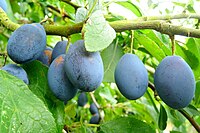
Photo from wikipedia
The genotyping of European fruit tree collections has helped to identify synonyms, determine parentage, reveal key specimens in the collections and provide information on the development of modern cultivars from… Click to show full abstract
The genotyping of European fruit tree collections has helped to identify synonyms, determine parentage, reveal key specimens in the collections and provide information on the development of modern cultivars from one or several progenitors. However, studies on European plum Prunus domestica L. accessions have been lagging behind, mainly because of the hexaploid chromosome number. In this co-operative study, 104 accessions conserved by 14 partners across Europe were phenotyped for 20 descriptors, and genotyped for 8 SSR loci together with 8 reference cultivars. Based on the descriptors and additional information supplied by the partners, as well as the scientific and horticultural literature, each accession was assigned to one of six pomological groups; (1) egg plums sensu lato (E), (2) prunes of the French d’Agen type (P/A), (3) prunes of the Central-Southeast European Zwetschen type (P/Z), (4) greengages (G), (5) mirabelles (M) and (6) bullaces, damsons and var. pomariorum (D/B). A MANOVA conducted on descriptor data revealed significant differentiation among the pomological groups as well as a geographic impact on the differentiation of local plum accessions in Europe. SSR data showed that two trios and seven pairs of genotypes had very similar allele profiles and possibly are genetically identical in spite of different accession names. An AMOVA indicated sparse genetic differentiation when accessions were grouped according to geographic origin whereas significant differences were obtained among pomological groups. A Bayesian analysis of genetic structure, as well as a discriminant analysis of principal components (DAPC), further revealed levels of similarity among and within the different pomological groups, suggesting that egg plums sensu lato (E) and greengages (G) can be referred to subsp. domestica while damsons and bullaces (D/B) but also Central-Southeast European prunes (P/Z) show more affinity to subsp. insititia. The small and possibly heterogeneous groups with mirabelles (M) and prunes of the d’Agen type (P/A) take an intermediate position suggesting a hybridogenic origin.
Journal Title: Genetic Resources and Crop Evolution
Year Published: 2020
Link to full text (if available)
Share on Social Media: Sign Up to like & get
recommendations!